The trail Route to Freedom
Welcome to the trail that takes you to places connected with the liberation of Pilsen by the American army!
Interesting information awaits you that you may not have known yet.
Due to the situation associated with the covid-19 pandemic and the restrictions imposed by the Government of the Czech Republic, the Liberation Festival Pilsen 2021 could not take place in the traditional way, which is why this new trail was set up. You may make the journey throughout the year.
On the route, which is about 10 km long, there are 22 stops connected with the end of World War II in Pilsen. The start and finish are both located in Plzeňský Prazdroj, but the route can be walked in any order.
Stops of the route
Stop No. 1
Pilsner Urquell Brewery
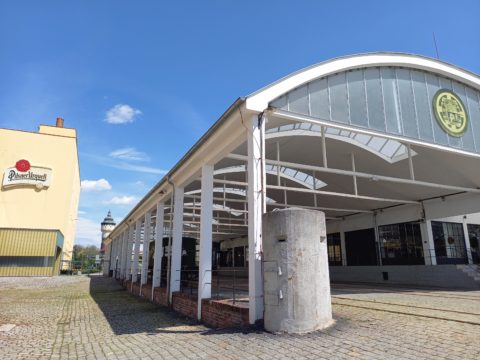
The Second World War fundamentally affected the development of both Pilsner breweries and their production. The brewery suffered from a shortage of raw materials, the vehicle fleet was confiscated by the German military administration, and some countries boycotted Pilsner Urquell as a German product, therefore exports were directed exclusively to Germany. The brewery produced “weak war beer” and survived only because it supplied beer to the workers at the Škoda Works. During the bombing at the end of the war, both breweries were extensively damaged and the Gambrinus brewery was almost destroyed. One reminder of this time is a small, but very interesting protective construction: the Splitterschutzzelle observation tower, which was also known as the Einmannbunker, or one-man bunker. These were precast concrete cylinders with narrow openings, probably even the first prefabricated fortress structures worldwide. They were usually built in factories, nevertheless weren’t used as shelters against air attacks since their construction wouldn’t have been sufficient for that. After the bombing was over, fire patrols used them to monitor the results of the air raid and to help to locate unexploded bombs.
Stop No. 2
“Na Obcizně” - at the confluence of the Mže and Radbuza rivers
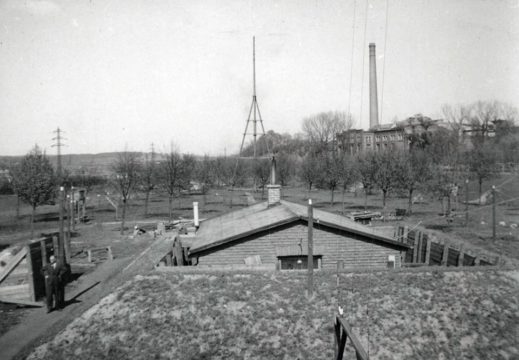
The memorial plaque at the confluence of the Mže and Radbůza rivers commemorates the day of the first free radio broadcast in the Czech language in the city of Pilsen at the end of the war in 1945. It was here, at a place called “Na Obcizně”, that the citizens of Pilsen – led by Karel Šindler, later the first director of the Pilsen radio studio – captured, after a dramatic battle, a German transmitter whose task was to jam the London broadcast. After the capture of this transmitter, famous words came from the air at 0:05 pm on May 5, 1945: “Pilsen speaks, free Pilsen speaks.” A replica of the German Luftwaffe’s medium-wave transmitter, which was placed here in 1945, is now located in front of the building of Czech Radio Pilsen on náměstí Míru. Further along the Mže River you will reach the Roosevelt Bridge and then take Roosevelt Street to the Republic Square. By the way, the Roosevelt street is named after the American president who was the head of the USA for practically the whole war. He died not long after his return from the Yalta Conference in April 1945 at the high point of the war, when the collapse of Hitler’s Germany was expected at any moment. Interestingly, under communism this street was not renamed in any form.
Stop No. 3
Republic Square
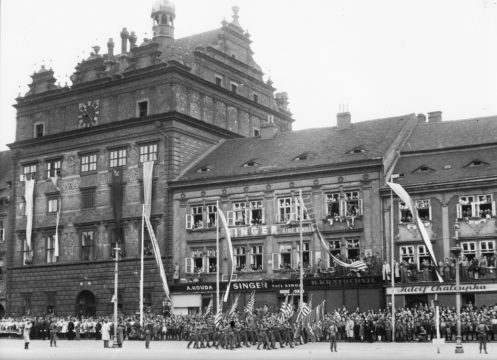
Náměstí Republiky – Republic Square was called Hlavní náměstí – Main Square during the war. It witnessed the welcome of the Americans after their arrival to Pilsen and the last resistance of the German soldiers from the cathedral tower on May 6, 1945. As the most important public space of the city, it was of course also the site of military parades. For example, on November 20, 1945, a ceremonial military parade was held here on the occasion of the farewell to the American army with the participation of Jan Masaryk, then Minister of Foreign Affairs.
Stop No. 4
Museum Patton Memorial Pilsen
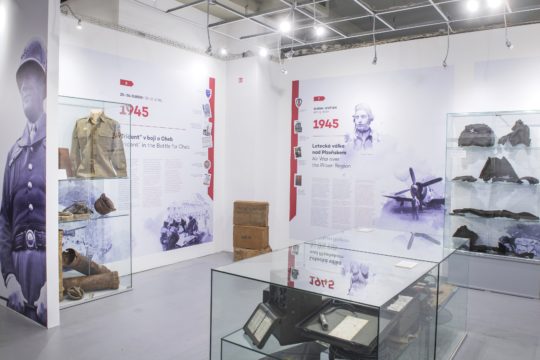
The museum was established with the support of the City of Pilsen in 2005. Most of the artifacts came from the collections of private collectors and introduce the visitors to the facts about the liberation of the city by the American army, which were not allowed to be discussed at all during the communist era. In 2019, a completely new exhibition was opened on the occasion of the 75th anniversary of the Allied landings in Normandy. It shows the Allied journey from the Normandy landings, through the Battle of the Bulge – Ardennes Counteroffensive, and on to western Bohemia. It focuses not only on the liberation itself, but on the post-war activities of American soldiers on our territory as well. It describes the wartime events in western Bohemia through authentic objects and memories of witnesses. The museum pays special attention to the legacy of the WWII veterans.
Stop No. 5
General Patton Monument
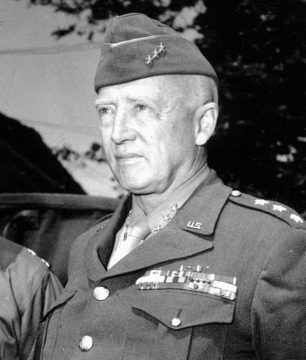
The monument to General Patton, under whose command the American army liberated Pilsen, was unveiled on May 1, 2015. Its design was created by sculptor Lubomír Čermák and architects Václav Zůna and Tomáš Beneš, who won an architectural competition announced by the city in 2009. Patton’s grandson, George Patton Waters, was also part of the jury.
The two opposing slender steles (9.5 metres high slabs, weigthing 10 tonnes) made of special rusted steel (corten) are intended to resemble the triumphal arch, the traditional symbol of victory. The rust on the seven-centimeter-thick plates itself is reminiscent of the armor of tanks, and also draws attention to the fact that the memorial was not built until 70 years after the war. The creation of the monument took about one year, it was made under the sponsorship of Vítkovice Ironworks. The monument to General Patton was intended to stand in Pilsen 10 years earlier, as a realistic statue that was created by Jaroslav Bocker. The foundation stone was laid in 2004 in front of the Peklo cultural center, but the town hall rejected the statue because of the artist’s cooperation with the communistic State secret police (“StB”). Since May 7, 2005 it has been standing in the nearby village Dýšina, where the headquarters of the 22nd Corps of Patton’s 3rd U.S. Army was located.
Stop No. 6
Stolpersteine - sady Pětatřicátníků No. 6
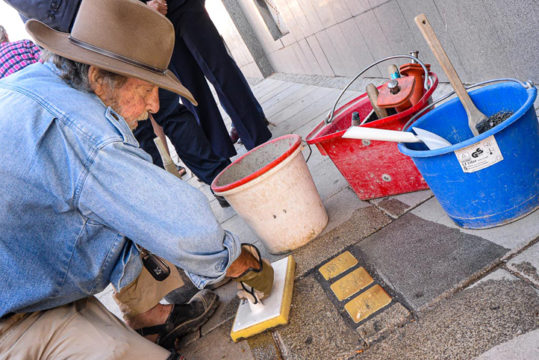
Stolpersteine (“stones of the disappeared”) are memorial stones commemorating the victims of the Holocaust. These paving stones with a brass surface are set into the pavements in front of the houses where Holocaust victims lived before they were forcibly moved into mass accommodations or deported. The author of the Stolpersteine project is the German artist Gunter Demnig (www.stolpersteine.eu). So far, more than 75,000 Stolpersteine have been installed in 26 countries almost all over Europe. In 2008, the Czech Republic joined in. In front of the house No. 6, you can find three Stolpersteine with the names of members of the Fanta family.
Note: the expression “stones of the disappeared” is actually a very free translation of the German term Stolpersteine. In fact, Stolperstein usually means an obstacle, a stumbling block, literally a stone to trip over.
Stop No. 7
The Great Synagogue
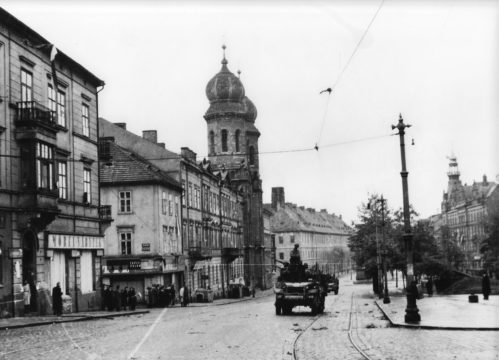
The Great Synagogue, the 3rd largest in Europe and the 5th largest in the world, became the property of the Reich during World War II. Its towers were identified as being suitable for anti-aircraft observation, it was also used as a storehouse for confiscated Jewish property and later for making uniforms for German soldiers. After World War II, it reverted to the Jewish community and was used for religious services until 1973. In 1992, it was declared a cultural monument and subsequently partially reconstructed. During the reconstruction, a bullet was left in one of the tablets of the Ten Commandments, near the commandment “Thou shalt not kill”, which was pierced during the liberation of the city in 1945.
Tip: Behind the synagogue there is a park, not very well known one, named after the Pilsen-born actor Miroslav Horníček. There is a “mini” memorial made from parts of the original pylons of the “Thank you, America!” monument, which you will soon reach. You can also take this back way to Husova Street, our next stop.
Stop No. 8
Husova Street
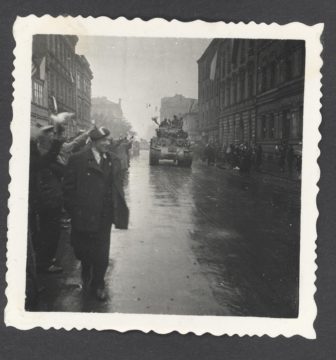
Monument to the 16th Armored Division
The monument, consisting of a pyramidal steel structure with a glass peak situated in front of the Czech National Bank, was unveiled in 2000. The 16th Armored Division of the United States Army under the command of John L. Pierce was founded in 1943. Its members arrived to Pilsen through Husova Street as the very first American soldiers, in the early morning hours of May 6, 1945.
House in Husova Street No. 3
Before the Second World War, this house was the seat of the “Humanitarian Lodge of the Union B’nai B’rith”, the first lodge of the oldest worldwide Jewish organization in the territory of the present Czech Republic. The society brought together lawyers, doctors and intellectuals and participated in the social life of the city and supported it. On its dissolution on May 9, 1939, Masonic symbols were found in the building (a silver key and a silver hammer). In the same year, the house became the property of the NSDAP (National Socialist German Workers’ Party), which established its regional secretariat there. The Pilseners called the building nothing else than “the brown house”. On May 6, 1945, just as Pilsen was welcoming American soldiers, the Communist Party of the Czechoslovak Republic demanded that the house be cleared of the occupiers and become its property. The request was granted the same day and the house became the headquarters of the regional secretariat of the Communist Party. The building was given the new nickname “Lenin’s House”. From the 1960s on-wards, it was used by the Škoda factories. This inconspicuous semi-detached house, whose individual users and building history faithfully reflect the dramatic history of the 20th century, is now used by the Faculty of Medicine of Charles University in Pilsen as the seat of the Dean’s Office.
Monument to Czechoslovak soldiers
During the celebrations in May 2012, a monument to Czechoslovak soldiers who fought on the Western Front in 1940-1945 was unveiled in Husova Street. It is stylized in the form of a Tobruk bollard, and on the sides the names of places where Czechoslovaks were serving in ground units in the West, especially in the Czechoslovak Independent Armored Brigade, are engraved. A cast of a British military helmet worn by Czechoslovaks during the Second World War is placed at the top of the bollard. The memorial is a creation of the students of the Private Secondary School of Arts and Crafts “Zámeček” in Plzeň.
About five hundred members of Czechoslovak foreign military units were killed, died of war injuries, died in the line of duty or fell victims to various diseases in the West, North Africa and the Middle East between 1939 and 1945. This monument at the intersection of Husova Street and Sady Pětatřicátníků (Petatřicátníků Gardens) is also a reminder of the repression of soldiers of the Western Resistance by the Communist regime in 1948-1989, when they were persecuted, imprisoned or even executed.
Stop No. 9
"Thank You, America!" Memorial
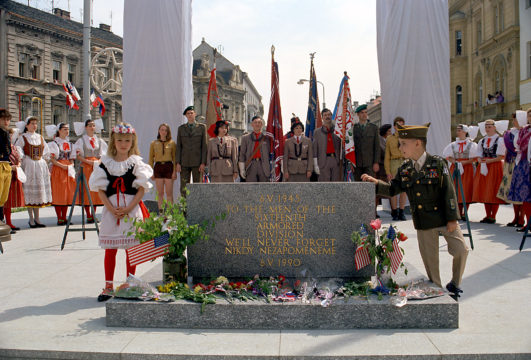
The “Thank You, America!” Memorial consists of two monumental granite pylons, over 6.5 meters high, and a circular bronze plaque set into the ground.
Shortly after the war, the cornerstone for the predecessor of the present memorial was located on this site. However, it was removed after 1948. The laying of the new cornerstone took place in 1990 on the occasion of the visit of the President Václav Havel and the US Ambassador Shirley Temple-Black to the first celebrations of the liberation of Pilsen by the US Army after 1989. The competition for the design of the future memorial, announced in 1993, was attended by 50 authors. The jury chose the winning design by Vladimír Preclík. However, it was rejected in the public debate. His bronze model in one-third size is on display in the town hall. The present-day appearance of the memorial is the result of a workshop organized by the Pilsen City Hall. The work is officially considered a collective anonymous work.
The unveiling ceremony took place on May 6, 1995 during the celebration of the 50th anniversary of the liberation of Pilsen by the American army. Due to the damage to the pylons, the monument had to be restored and was unveiled again in 2018.
Stop No. 10
Klatovská Avenue No. 19
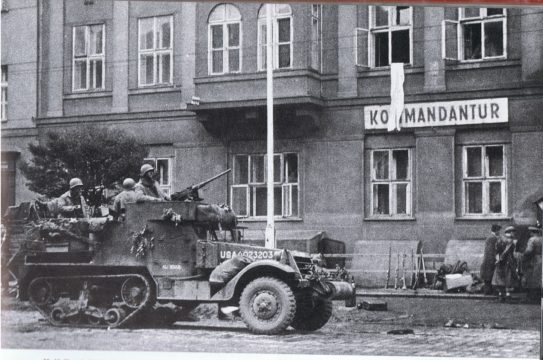
In the early 20th century, the architect Adolf Loos was active in Pilsen. He designed the reconstruction of the so-called Brummel House and 13 apartment interiors. Experts consider Loos’ interiors to be one of the greatest gems of Pilsen. From the point of view of the contemporary perception of monuments of modern architecture, this ensemble is also valuable in the context of the entire European architecture of the 20th century. One famous interior is at Klatovská Street 12, directly opposite the “Thank You, America!”
There is another apartment at Klatovská Street 19, that of Hugo and Helena Semler, whose generous reconstruction was also undertaken by Adolf Loos. In 1941, two years after the enforced emigration of the Semler family to Canada, the German military headquarters was situated in the house. At the end of the war, it was here that the dramatic negotiations on the German surrender took place. A spontaneous revolution of Pilseners broke out before the arrival of American and Belgian soldiers, when resistance fighters and Czech police occupied all important buildings in the city on the morning of May 5th. However, the commander of the German garrison in Pilsen, General Georg von Majewski, refused to surrender to the Czechs and ordered his troops to resist and hold out until the arrival of the American forces.
He signed the surrender into the hands of American Lieutenant Colonel Percy Perkins only in the afternoon of May 6, 1945. After signing, von Majewski pulled out a concealed weapon and shot himself in front of his staff and his wife Elisabeth. After the war, the house remained state property and was used for military administration until 2002.
Klatovská Avenue in the Changes of Time
Klatovská Avenue (Klatovská třída), where you are just walking, is one of the most frequently renamed streets in the city. From 1879 until the foundation of Czechoslovakia, the part of the street between the Smetanovy sady and Hálkova Street was named after the Austrian Emperor and the last Czech King Ferdinand I. In 1918 it was renamed Czech Legionnaires’ Avenue in honor of the participants of the foreign military resistance during the First World War. Further name changes were caused by the establishment of the Protectorate, the events of the Second World War, the liberation of Czechoslovakia and the establishment of the post-war regime in the following order: Klatovská Avenue (1940-1943), Reinhard Heydrich Avenue (1943-1945), in the part from the center to today’s náměstí Míru (Peace Square) Benes Avenue (1945-1951), May 1st Avenue (1951-1991) and since 1991 Klatovská Avenue again.
Stop No. 11
Chodské Square
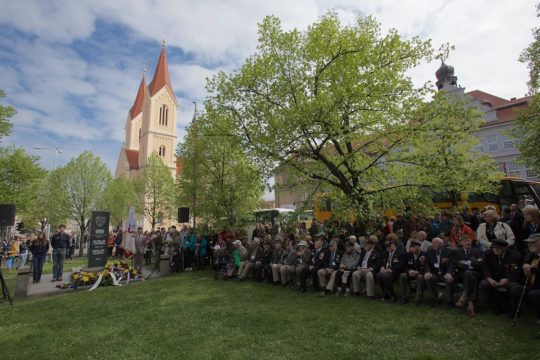
The memorial to the 2nd Infantry Division of the United States Army was unveiled on Chodské Square in 1990.
You can find the division’s emblem on the pylon of the memorial. This famous emblem has an interesting history. While this division was fighting in France during World War I, the commanding colonel, Colonel Herringshaw, held a contest to design an identifying emblem for his unit. The winning design was the head of an Indian with a headdress, the 2nd place winner was a white five-pointed star. The Colonel decided that the final design should be a combination of these two designs. In November 1918, the coat of arms with the so-called Gauden Indian used on the five-dollar coins was officially approved, as the original Indian head was “rather crudely constructed”.
Stop No. 12
Monuments on náměstí Míru (Peace Square)
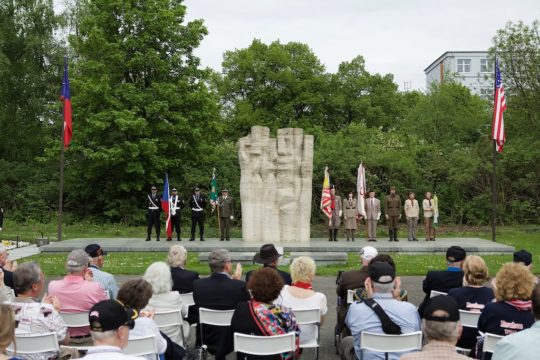
Several monuments can be found on náměstí Míru (Peace Square), which still has preserved its park character. As early as 1946, this square was chosen for the location of a memorial to the victims of fascism and the wars in Pilsen. The memorial was erected only in 1967 on the basis of a previous competition. The winning design was the travertine sculpture “People” by the sculptor Slavoj Nejdel, which represents the clenched formation of figures facing violence. The horizontal granite pedestal with the motto “Honor to the one who defends himself, he can give his life for liberty” was designed by architect Hynek Gloser sr. The memorial in the spatial center of the square was reconstructed in 2010. After the closure of the Bory military airfield in 1996, a monument dedicated to the Czechoslovak military pilots of the Second World War was moved here.
Another memorial is dedicated to the victims of the May 1945 uprising in Pilsen. It broke out in the early morning hours of May 5th, 1945. All resistance organizations from Pilsen and its surroundings were involved. The Pilseners, despite the lack of equipment and 7,500 Wehrmacht men in the city, occupied the most important strategic objects. The Revolutionary National Committee seized the city hall, the resistance fighters took over the main post office and the railway station, the workers took control of the Škoda factories, the police secured their stations and the German military broadcasting station “Na Obcizně”.
The uprising was ended by the arrival of American soldiers of General Patton’s Third Army in the morning hours of May 6, 1945. Thanks to the Pilsen insurgents and the German soldiers’ interest in getting captured by the Americans, there was no major bloodshed in Pilsen and a large number of German soldiers waited for the arrival of the American army in the barracks.
Stop No. 13
Čechova Street No. 34
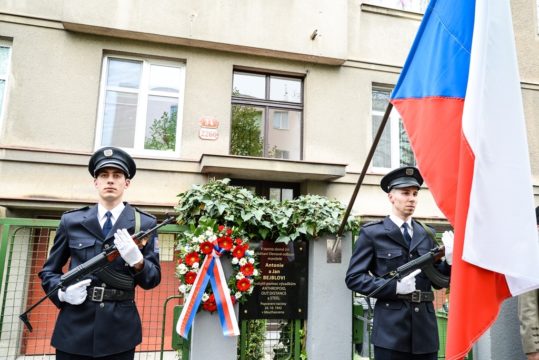
Three memorial plaques were unveiled in honor of the Pilsen resistance fighters in Čechova Street, Resslova Street and Klatovská Avenue in 2017.
The families who lived at these addresses helped the paratroopers in Operation Anthropoid. The Canonbury operation, which aim was to disable the production of the Škoda factory in Plzeň, was fatal for them. Jozef Gabčík, Jan Kubiš, Adolf Opálka and Josef Valčík arrived in Plzeň on the April 17th 1942 and Karel Čurda on April 23rd. During their stay in Plzeň, they stayed at the addresses mentioned above. However, the operation ended in failure. On June 16th, Karel Čurda reported to the Gestapo control room in Prague and gradually revealed all those who had helped him during his illegal activities. Subsequently, all of them were arrested, sentenced to death and executed in the Mauthausen concentration camp on October 24th 1942.
Stop No. 14
Winter stadium of Pilsen
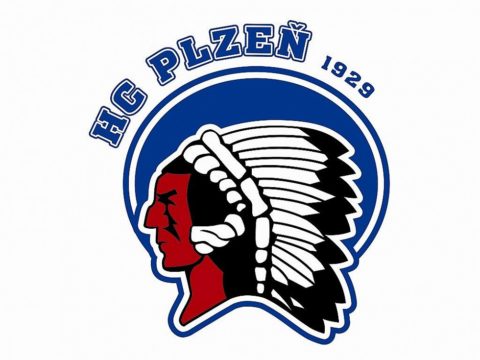
We are going back in the direction of the ice hockey arena, the home of HC Škoda Plzeň. It is no coincidence that the Plzeň hockey team has had an Indian in its emblem since 2009 – the emblem of the 2nd Infantry Division of the US Army was the inspiration for the graphic designer Jiří Světlík. On Štefánik Square, on the house No. 1, there is a memorial plaque to the Victims of Communism – a memorial to the Czechoslovak officers executed by the Communist regime in 1952. Then you will go down to the river and continue along it for less than a kilometer along the nature trail through the Radbuza Valley. On your left you will pass by the former depot of transport companies, now one of the most important cultural zones of the city called DEPO2015. Next, you pass an interesting railway bridge over the Radbuza River and then opposite the weir called “U Mráčku” you will find on your left one of the most daring construction works of its time in Pilsen – the Congregation House and the prayer room of the Koranda congregation. In the upper part of the Koranda congregation’s prayer house is a memorial plaque to the victims of the war and the air raid from the ranks of the Evangelical Church of Czech Brethren with the names of members of the congregation executed or martyred during the Second World War or who died during the May Uprising – almost 50 names in total.
Stop No. 15
Skyscraper U Mráčku - "At the Cloud"
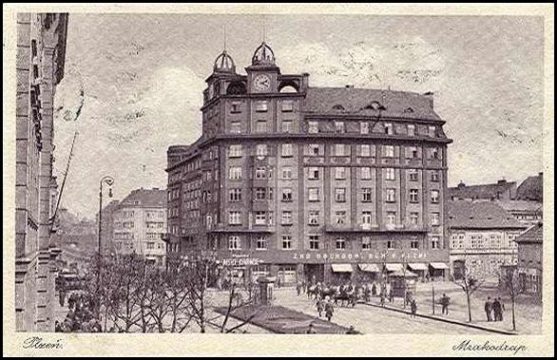
The nearly kilometer long Americká (American) Street leads from the main railway station across the Radbuza River to a place called “U Práce”, where it connects with Klatovská Avenue in the site of the “Thank You, America!” monument. The western, upper part of Americká Street on the left bank of the Radbuza river was formed by the gradual transformation of the road leading along the suburban fortifications in the south of the historical center. The area around the eastern section of today’s Americká Street was a place of suburban gardens and farms for a long time. It was not until the introduction of the railroad and the opening of the station in 1862 that this area began to change. At the end of the 19th century, a section of Americká on the right bank of the Radbuza River was designed as a boulevard connecting the station area, or Pražské Předměstí (Prague Suburb), with the city center. The rich history of the city and the country is documented in the various names the street has had: successively Stodolní (Barn), Jungmannova (Jungmann – a Czech poet and linguist, a leading figure of the Czech National Revival), Emperor Franz Josef, Wilsonova (Wilson), Karla IV. (Charles IV), Stalinova (Stalin), Moskevská (Moscow), Ludvík Svoboda and again Moskevská (Moscow), now Americká (American). The place on Americká behind the exit of the Wilson bridge on the way from the railway station is called U Mráčku by Pilseners – this name is also given to the weir on the Radbuza we passed. Why? The house on the corner of Prokopova, Americká and Anglického nábřeží Streets, built in 1924, was the highest building in the city at that time thanks to its eight floors. Hence the name “Mrakodrap – Skyscraper”, known by Pilseners mostly as “Mráček”. The skyscraper has been protected as a cultural monument since 1994.
Tip: Another “Stolperstein” can be found nearby at 10 Goethova Street – the stone is named Max Winterstein.
Stop No. 16
Martinská Street No. 3
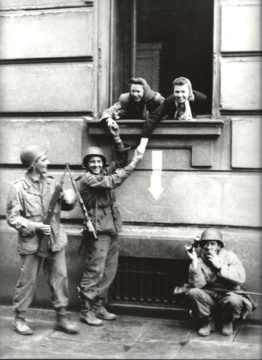
At the moment when the sirens informing of the approaching air raid began to howl during the war, arrows on the houses pointed to people from far away in the direction of the nearest shelter. The large colored arrow in Martinská 3 is the only one in Pilsen that includes, in addition to the Czech inscription “K veřejnému protileteckému krytu – To the public air-raid shelter”, the German inscription “Zum öffentlichen Luftschutzraum”. It is protected and restored from the time of its discovery during the facade repairs. In other places, less conspicuous arrows to the shelters can still be found on the houses if you pay a little attention, but their number is diminishing as the facades are being repaired.
Stop No. 17
Hotel Slovan
Shortly after the German invasion of the former Czechoslovakia on March 15th, 1939, a German headquarters was established in this hotel. After the liberation, the American army had its headquarters here.
The hotel also witnessed one of the many actions during communism aimed at manipulating the events of May 1945, when the subject of liberation by the Americans was a great taboo. In May 1952, an exhibition entitled “The Shameful Role of the American Occupiers in Western Bohemia” was held here. It presented ‘guaranteed’ information about the American demons in a similar vein to the book of the same name, which showed the ‘real’ reality. The authors portrayed the American army as an occupying force that had committed many crimes on our territory; American soldiers were portrayed as chewing barbarians interested only in violence, illegal trade and pornography.
Stop No. 18
Old Synagogue
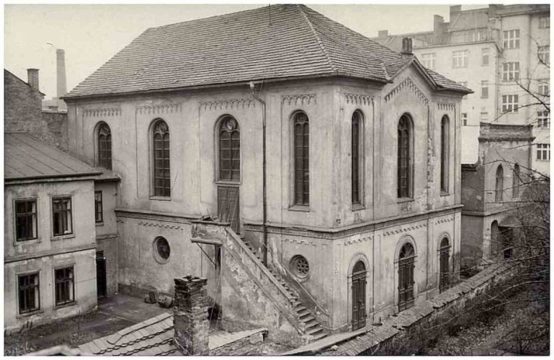
The Old Synagogue, built in 1858-1859, served the Jews of Pilsen until World War II. A memorial to the victims of the Holocaust in Pilsen was built in 2002 on the neighboring place, where another synagogue, called the auxiliary synagogue, had stood since 1875 and was still used as a Jewish school at the beginning of the 20th century. The place is known as the “Garden of Memories”. The memorial is composed of stones, each inscribed with the name and date of birth of one of the victims who did not survive the Nazi genocide. Of the 2,604 Jews deported from the Pilsen main station to Terezín in January 1942, only 204 survived to the end of the war.
Please note: The synagogue is not open during the Sabbath (i.e. on Saturdays), so it is not possible to enter the Garden of Memories.
Stop No. 19
Hotel Continental
Hotel Continental is one of the most important buildings in the center of Pilsen. During an air raid in December 1944, the southeastern part of the building was hit by a bomb, which flew through the roof skylight through all floors and exploded in the basement. In the shelter of the hotel, which was considered one of the safest in the city, 70 people died, including the owner Václav Ledecký and his son Emanuel and his father-in-law Arnošt Egert.
After the liberation of Pilsen by the American army in May 1945, the hotel became the temporary headquarters of General Hinds of the famous 2nd Infantry Division. Among the most important hotel guests was the famous artist Marlene Dietrich – not everyone knows that she came to Pilsen together with the Americans and helped as a translator.
Next, you will slowly return to the Pilsner Urquell Brewery along the Radbuza River, this time through the Anglické nábřeží (English waterfront), which has also changed names over time. The original English waterfront was called German from 1940, then English again after 1945, then Kharkov from 1949 and only in 1991 it became English waterfront again.
Stop No. 20
Police headquarters building known as the "Gestapo" - Anglické nábřeží No. 7
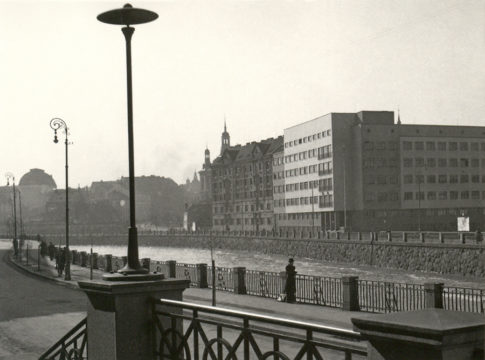
This building was popularly called the Gestapo after the temporary headquarters of the German secret police. The functionalist Police Headquarters building was built in 1934. During air raids at the end of World War II, the fourth and fifth floors of the building were damaged, as well as its attic. After the war, a memorial plaque to the anti-Nazi fighters was installed next to the main entrance of the building. During the years of socialism, the building was used as an interrogation room for the State secret police (“StB”).
Stop No. 21
The Building of the Sokol Movement
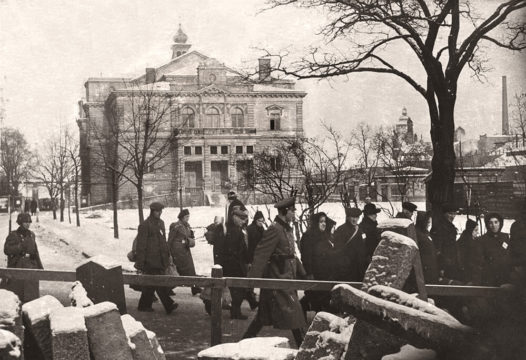
The important heavy industry of the Pilsen region was undoubtedly one of the reasons why the local Jews were among the first to be deported. The Sokol Movement building became a gathering place for the Jewish population of Pilsen and the surrounding area in January 1942, due to its convenient location near the train station. The auxiliary service of the Jewish Religious Community helped in the organization of the transports, for example by providing the necessary items for the transport and packing luggage, as well as babysitting small children. Lonely, old and infirm people were also dependent on its help. The Jews of Plzeň were summoned to the meeting place in the Sokol Hall by the hour. They were allowed to take five days’ worth of food and, above all, warm clothes in their hand luggage. The collection service took the luggage to the assembly place. On designated days, armed units of the German Protective Police/Schutzpolizei took them to the station. Each of the prisoners wore a tag around their neck with their name, a letter indicating the transport and a serial number. On the 18th, 22nd and 26th of January 1942, a total of three transports – trains marked R, S and T – were dispatched from the Pilsen railway station. 2 604 people were deported.
Stop No. 22
The house U Prazdroje No. 17
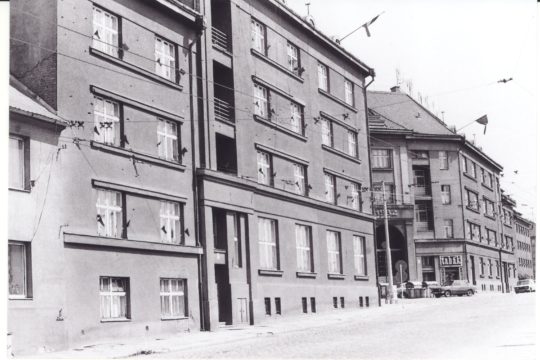
The plaque on the house commemorates an event of May 1945, when one of the last shots was fired here during the liberation of Pilsen by the members of the 16th Armored Division of the U.S. Army. A piece of the original plaster remains on the house as a reminder of the war. You can still find several houses in Pilsen with plaster that shows bullet holes, even many years after the end of the Second World War. This is one of them.